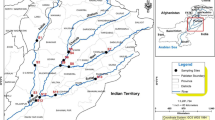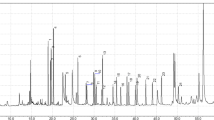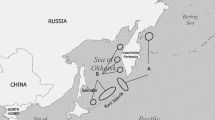Abstract
Concentrations of organochlorines (OCs) representing persistent organic pollutants (POPs), such as polychlorinated biphenyls (PCBs), dichlorodiphenyl trichloroethane and its metabolites (DDTs), chlordane compounds (CHLs), hexachlorocyclohexane isomers (HCHs), and hexachlorobenzene (HCB), were determined in the liver of skipjack tuna (Katsuwonus pelamis) collected from the offshore waters of various regions in the world (offshore waters around Japan, Taiwan, Philippines, Indonesia, Seychelles, and Brazil, and the Japan Sea, the East China Sea, the South China Sea, the Bay of Bengal, and the North Pacific Ocean). OCs were detected in livers of all of the skipjack tuna collected from the locations surveyed, supporting the thesis that there is widespread contamination of persistent OCs in the marine environment. Within a location, no significant relationship between growth-stage (body length and weight) and OC concentrations (lipid weight basis) was observed, and the OC residue levels were rather uniform among the individuals. Interestingly, the distribution of OC concentrations in skipjack tuna was similar to those in surface seawaters from which they were taken. These results suggest that OC concentrations in skipjack tuna could reflect the pollution levels in seawater from which they are collected and that this species is a suitable bioindicator for monitoring the global distribution of OCs in offshore waters and the open ocean. Concentrations of PCBs and CHLs in skipjack tuna were higher in offshore waters around Japan (up to 1100 and 250 ng/g lipid wt, respectively), suggesting the presence of sources of PCBs and CHLs in Japan. High concentrations of DDTs and HCHs were observed in samples from the Japan Sea, the East China Sea, the South China Sea, and the Bay of Bengal (up to 1300 and 22 ng/g lipid wt, respectively). This result suggests recent use of technical DDT and HCH for agricultural and/or public health purposes in Russia, China, India, and some other developing Asian countries. Relatively high concentrations of PCBs, CHLs, HCHs, and HCB were also observed in samples collected from some locations in the middle of the Pacific Ocean, indicating the expansion of OC contamination on a global scale. Considering these facts, continuous studies monitoring these compounds in offshore waters and the open seas, using skipjack tuna as a bioindicator, are needed to further understand the future trend of contamination.
Similar content being viewed by others
Author information
Authors and Affiliations
Rights and permissions
About this article
Cite this article
Ueno, ., Takahashi, ., Tanaka, . et al. Global Pollution Monitoring of PCBs and Organochlorine Pesticides Using Skipjack Tuna as a Bioindicator. Arch Environ Contam Toxicol 45, 378–389 (2003). https://doi.org/10.1007/s00244-002-0131-9
Issue Date:
DOI: https://doi.org/10.1007/s00244-002-0131-9




